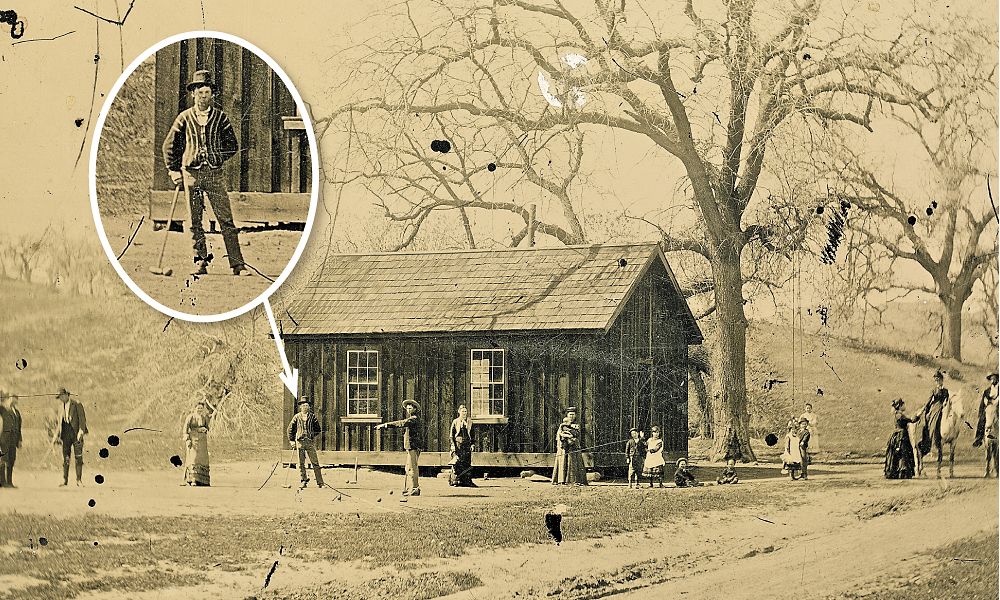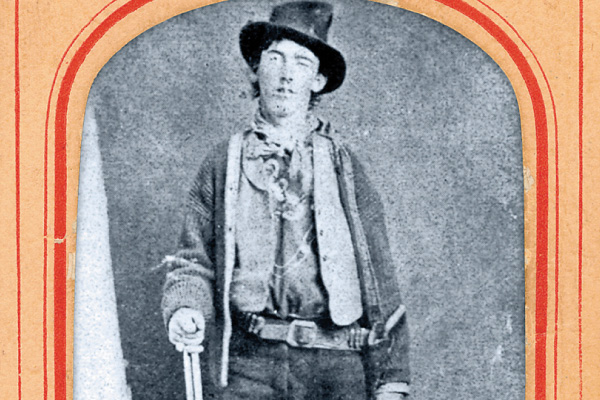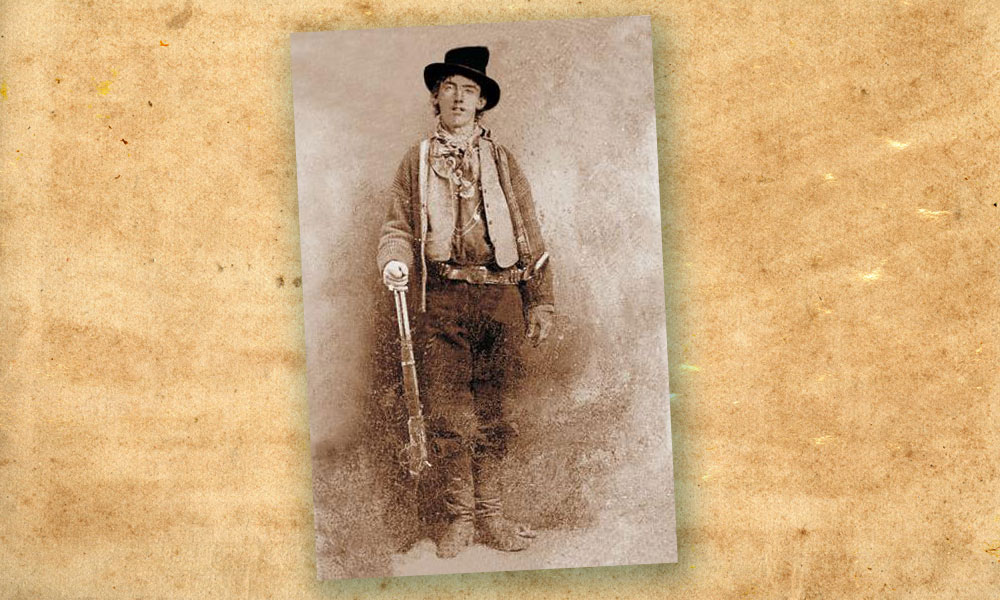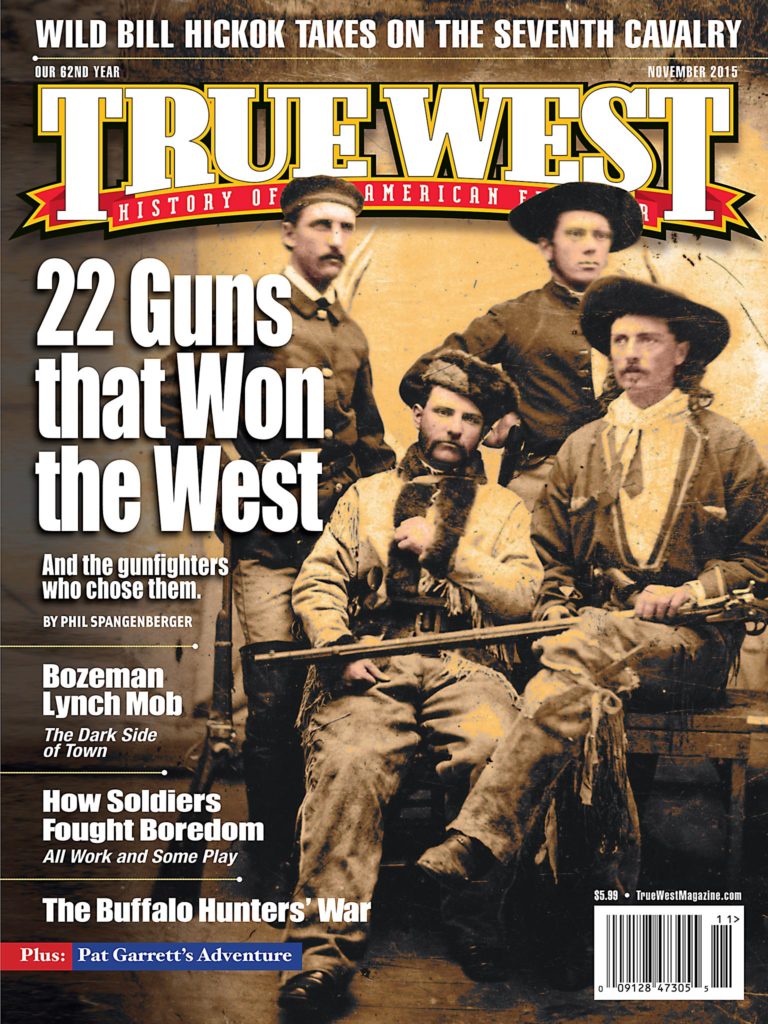
Click here for the rebuttal from Jeff Aiello, Co-Executive Producer of the upcoming documentary Billy The Kid: New Evidence
The juggernaut of publicity for the National Geographic Channel show airing on Sunday, October 18, is nothing short of phenomenal. We started getting e-mail requests last week about the alleged new photograph of outlaw Billy the Kid, which we first discussed in our special Billy the Kid issue (June 2015). Readers begged for our input and verdict on the so-called “croquet photo.” They all wanted to know one thing: “Do you think it’s really Billy?” Short answer: We think the publicity is genius, but no one in our office thinks this photo is of the Kid.
We polled some of our writers and researchers who have spent a good part of their lives studying the Kid. These are the guys we trust and respect. Here are their responses:
“…that photo described as ‘Billy the Kid playing croquet’ [was] supposedly found in a Fresno, California, ‘junk shop’ by a certain Randy Guijarro—who paid ‘a couple of bucks’ for it ( some accounts state he paid 67 cents ). These accounts go on to say that this junk shop photo is ‘now worth $5 million.’ I guess I’ll have to see how many millions I can make by selling the photo I found in a dumpster in East Overshoe, which shows Belle Starr and Calamity Jane playing hopscotch on the Brooklyn Bridge.”
—Jack DeMattos, author of “The Search for Billy the Kid’s Roots is Over,” Real West, January 1980
“Without a solid provenance linking a historic photograph to the Kid, it can never be anything more than simply a photo of a goofy-looking juvenile who bears a resemblance to one William H. Bonney. Such images are hardly rare—unfortunately.”
—Mark Lee Gardner, author of To Hell on a Fast Horse: The Untold Story of Billy the Kid and Pat Garrett
“Aside from lacking any provenance, this photo is from such a long distance that it’s impossible to discern physical attributes, much less facial features. This is simply another of the long chain of want-it-to-be-the-Kid pictures. This one poses even less credibility than its predecessors. We so-called experts have been showered with a flood of Billy pictures that their owners were sure were Billy because they looked like Billy.”
—Bob Utley, author of Billy the Kid: A Short and Violent Life
“When I first saw it two years ago, the owner only thought the one was Billy the Kid because he had a sweater on, and he thought the hat looks like the one in the authentic photo. But the promoters he was somehow able to get involved are leaving money on the table at $5 million because they failed to identify Jesse James, Wyatt Earp, Calamity Jane and Wild Bill Hickok who are also obviously in the photo.”
—Robert G. McCubbin, world-famous collector of historical Old West photographs
“Bob McCubbin and I told the owner two years ago it is not a photo of Billy the Kid. He refused to believe us and kept dragging it around to various auctioneers, trying to convince them it was real. Finally, he got Don Kagin to accept it. Bob and I have explained in detail to everyone involved why the image has no value. This photo has no more provenance than any of the scores of alleged Billy the Kid images which have appeared on ebay the past 15 years. And don’t talk to me about facial recognition software. When it comes to two-dimensional historic images, it just doesn’t work.”
—John Boessenecker, California outlaw historian
“Regardless of what is said by paid ‘experts,’ their conclusions are CONJECTURE, not FACT. No matter how sophisticated the hype that accompanies them, it’s still hype and nothing else. The ‘proof’ they offer is nothing more than wishful thinking, and the historical value of the image is zero.”
—Frederick Nolan, author of The West of Billy the Kid
“I’ve looked at that photo, and I don’t see how anyone can definitely ID anybody in it. It’s hard enough to took at a head shot and be sure without other provenance. Heck, I could look at old photos of Brad Pitt and Robert Redford and swear it’s really me in that photo.
—Marshall Trimble, Arizona’s Official Historian and True West’s answer man
“Yes, the documentary has yet to be shown. But from what I’ve seen and read and heard, I think the photo is a tempest in a teapot—or worse, it’s sheep dip. No id’s. No date. No location. No provenance. No way.”
—Mark Boardman, True West’s features editor
“There is a big difference between documentation, which is a document trail that leads back to day one, and authentication, which merely identifies the picture as being from a particular period and sometimes, a place. Personally, I still have to go with documentation.”
—Drew Gomber, Lincoln County historian
“The Times of London called me yesterday for a quote on the photo. As always, Billy is an international phenom. The fascination is, well, fascinating. Part of this is lost treasure interest, but most of it reflects the enduring appeal of Billyiana. A photo with no provenance whatsoever picked up in a flea market causes all this commotion—and a tv special to boot. Billy the Kid just keeps riding…”
—Paul Andrew Hutton, distinguished professor of history at the University of New Mexico and author of “Dreamscape Desperado,” True West, May 2007
Kevin Costner narrates the two-hour documentary that airs on 9 p.m. ET this Sunday on the National Geographic Channel.
REBUTTAL
Jeff Aiello, Co-Executive Producer of the upcoming documentary Billy The Kid: New Evidence, sent us a rebuttal to our post on the photograph on October 15, 2015 at approximately 7:30am MST.
True West – “experts” chime in on Billy The Kid – croquet photograph authenticity
The newly discovered photograph of Billy The Kid and The Regulators has certainly ignited a firestorm of interest and controversy. The remarkable tintype featuring William Bonney and several of the men that called themselves The Regulators, posed in an outdoor scene playing croquet has, unfortunately, divided a community of those who deeply care about history of The Kid and the Lincoln County War.
Randy Guijarro came to possess this photograph purely by luck, or what some would call fate. He walked into a junk shop in Fresno, California in 2010 after hearing that two young men were selling old photos and documents out of a shoebox, not realizing what valuable inventory they carried. Randy bought 3 ferro-types for $2. One was the photo the world knows about today. He didn’t realize what he had until he got home.
After bringing it home and studying it under his loupe, he quickly noticed a resemblance to the icon-photo of Billy The Kid the world has known for generations. After doing a little research, he also noticed that two other figures in the photograph closely matched known photos of two men that are well-known to have ridden with Bonney; Tom O’Folliard and Charlie Bowdre. Figuring that the chances three individuals that were all known to ride together in Lincoln County, New Mexico between 1878 – 1880, all seen in one photograph were extraordinary, he began to do what anyone would do…seek out the experts for their opinions to see if what he had was real.
In 2011, after the Upham-photo of Billy The Kid sold for $2.3 million, Randy reached out to the experts for the first time. He met with Brian Lebel at a show in Grass Valley, CA and showed him the actual tintype along with a high-quality enlargement of the image. Before Brian could really comment, another historian-author, John Bossenecker, quickly crowded into the meeting, glanced at the image and dismissed it immediately citing that the landscape and trees didn’t match New Mexico and, with a fair amount of conviction, stated that the scene was most likely in California. After Bossenecker left, Lebel pulled Randy aside and told him he had some work to do to prove the photo was authentic, but if it was, it could be worth 10-times that of the icon-photo of The Kid…Lebel’s words.
Randy, being sure of what he had, was not deterred. In fact, without even realizing it, John Bossenecker was the inspiration for a long journey Randy would take to find the truth.
The next person Randy showed the photo to was John McWilliams, a noted expert in 19th century photography best known for his Texas Rangers collection. McWilliams has looked at and shot-down 4 purported BTK images before…all in a matter of seconds. McWilliams looked closely at Randy’s image and two hours later, was still looking at it. John identified the actual tintype as a late-1870s plate and verified clothing worn by the subjects in the photo to be accurate to the late-1870s. He also felt the person believed to be Bonney in the photo had several matching markers to the icon-photo including the hat, sweater-type, stance, sloped-shoulders and eyebrows. He also felt the person believed to be Charlie Bowdre in the photo strongly matched known photos of the famous gunman. Like Brian Lebel, McWilliams told Randy to keep on searching for more information and documentation to support the image. He ended the meeting by telling Randy that if he could find the location the photo was taken and it all matched up, that would be the clincher for proving the photo’s authenticity.
In 2013, after having looked at the photo several more times, McWilliams finally arranged a meeting between Randy and photo-collector Robert McCubbin. The meeting was set up so McCubbin could see the tintype and enlargement and hopefully, for Randy, give the photo a hard look to determine if it was the real deal. When Randy walked into a Las Vegas hotel room to share his photo with McCubbin, John Bossnecker was there too, and Randy knew he was sunk. Still, he rolled out the large image for McCubbin who looked at it for only seconds and dismissed it quickly for the same exact reasons Bossnecker had given in 2011.
The meeting quickly ended and Randy started the next phase of his journey with an important question; how could two experts in old-west photography (McWilliams and McCubbins) have such a different take-away on the same image? Randy was dejected and put the effort to authenticate the photo aside for a while.
I met Randy in October of 2014 by chance and learned of the story written above. After spending two months working with Randy’s tintype and diving into the history of the Lincoln County War, studying photographs and doing some low-tech photo-matching, I became convinced that the photo was probably authentic but was certain the system for photo-authentication in Western Americana needed an overhaul. Important pieces of American history and whether they are real or not, should not be left up to one or two men armed with nothing more than their own large collections and opinions. This is why I set out to make the documentary that will air Sunday night on National Geographic Channel.
I wanted to share this back-story above because knowing the context of what really happened and the players involved should help better frame the story for those that will now judge the evidence discovered for the ‘croquet kid’ tintype. As for my direct rebuttal to the comments made in the True West post/article yesterday…here we go:
First off, True West and the gentleman quoted in the post made a rather large error in judgment (in my humble opinion) without knowing or seeing the full body of evidence that has been discovered on this image. With the exception of Dr. Hutton, who does appear in our film and is very helpful in discovering documentation that supports the photo, the other’s comments were snarky, wining and lacking any facts to support their positions. We know, as the people bringing the photo to the public, that the burden of proof is on us with this image. The documentary on Sunday is our presentation of that proof. True West and these highly respected gentlemen should have waited until Monday to make their positions known simply because none of them have seen the full amount of evidence and proof that the led to the tintype’s authentication. I repeatedly asked Mr. McCubbin to look at all the proof but he was defiant and rejected the invitations. Ahead of the airing of the film, here are some bullet points to set the record straight and to refute the error-laden claims of True West’s “dream team” of historians and photo-collectors:
“The photo has no provenance or documentation”; Actually, we’ve discovered both. The first and most important piece of provenance in photography is the location the picture was taken. This is where the chain of custody begins. We have found the exact location the photo was taken and it has been verified by three, separate teams of investigators independent of the production of the film. Its also been verified by the current land-owner of what was the old Tunstall Ranch on the Felix River, Sterling Hendricks. The lumber structure seen in the croquet photo, which we now know was the Felix School built in 1874 (most likely by Casey), was actually built over in 1935 and became the Flying H School. We know this because we found some of the original boards and foundation elements underneath the structure that stands there today. Additionally and most compelling, the width of the building there today is 21’6’ wide. The measurements of the old building in the croquet photo are 21’6” wide. These measurements were made using the same computer application that positively identifies Bonney, Bowdre, Chisum and O’Folliard. The configuration of roof-pitch, windows and doors has certainly changed over time but the building’s measurements are strong facts, along with many others from the site, that prove this is the spot. Provenance established.
Next, facial-recognition. This is one is tough because quite simply, older people find accepting this technology difficult to accept out of a lack (or willingness) to understand it. Bossnecker’s comments about facial-recognition not working on 2D images is completely out of line and untrue. The facial-recognition expert we used on this project, Kent Gibson, is one of the most highly-respected forensic analysts in this field. The software used in positively identifying Billy The Kid, Tom O’Folliard, Sallie Chisum and Charlie Bowdre in Randy’s photo is the same system used to protect the United States from terrorist attacks. It works. Its finds and helps bring to justice people that would do us harm everyday and does this using 2D images. In fact, most of the time, the source material used is more grainy and in poorer shape than the croquet tintype. Its tough for me to understand how someone can sit safe in their office in San Francisco, protected by technology like that used in our film but then claim that same technology is incapable of matching William Bonney from two, usable sources.
“We don’t have any documentation”; Again, yes we do. Sallie Chisum’s hand-written journal from 1878 quite clearly explains when and where all of the people in the photograph came together and, when cross-referenced to known, historical movements of the players, establishes a narrow timeline the photo was taken within. This documentation also leads to and points directly at the Tunstall Ranch for where the photo was taken. History well-records the fact that Charlie Bowdre and Doc Scurlock moved their families from Ruidoso to Fort Sumner the first week of September of 1878. Evidence that will be shown in the film points to the croquet tintype being taken during this event.
“It doesn’t look like New Mexico…the trees don’t match”; This was the first citation of Bossnecker and McCubbin. According to Professor Owen Burney, at the University of New Mexico’s forestry studies, the trees have been identified as White Oaks. While on the fringe of their natural habit in the late 1870s, its well-documented that the nearby town of White Oaks, New Mexico in Lincoln County was named for a large stand of White Oak trees that grew near the stream east of town. Additionally, naysayers point out that if this photo was taken in early September, why are there no leaves on the trees? Again, Professor Burney cites that in times of severe drought, large trees will drop their leaves early to protect against mortality. We have documentation to prove that a severe drought was in play in south-eastern New Mexico between 1876 and 1883. In my opinion, Bossenecker and McCubbin should be disqualified as contributing “experts” in photo-authentication after missing this one so badly.
“Why would they being playing croquet?” “Where are their guns?”; The croquet element to the photo is the most interesting to me. When I emailed Fred Nolan back in March to ask him to look at the photo and contribute to the film (which he denied both), he thought the element of croquet in the photo with Billy was outrageous. Really? Does he forget that John Tunstall was English? Does he forget that on page 69 in his own book “The Life and Death of John Henry Tunstall” he writes about how much Tunstall loved the game and documents that he played it here in North America after immigrating from England? While we can’t prove with facts or evidence that the croquet set seen in the photo is Tunstall’s, its at the very least a compelling link between the game and the people in the photo. As for the lack of guns, this is obviously a staged photo to celebrate some kind of special event. Our photo experts believe it was to celebrate the marriage of the two people seen on horseback in the photo based on how the photo is composed. We uncovered new documentation in our search that proves Charlie Bowdre and Manueal Herrera were actually married in 1878 and not in 1876 or 1880 as historians have guessed at for years. These documents have been provided by decedents of both and in probate court records of San Miguel County, the county Fort Sumner was located in 1878. We believe the record of their marriage was entered after they arrived in Fort Sumner.
The tintype itself was analyzed by noted wet-plate collodian photographer Will Dunniway. Will is considered one of the best itinerate artists in the world today. He date-stamped the croquet photo to a plate made between 1877 and 1881. The chemical process used to make the plate tells the tale. Residue and a close look at the media material itself is consistent with photographs made in that time-frame. Dunniway also confirms McWilliams findings that clothing worn is period-correct.
These are just some of the facts and findings we uncovered over years of research and work on this photo. Claims of a new Billy The Kid image should be met with skepticism simply due to the amount of false claims made. But at some point, with an image like the croquet photo, the over-whelming circumstantial evidence combined with solid provenance proves the image to be authentic. Never before has an image been put through such scrutiny or testing from a wide-range of photo-experts, historians and researchers and every one of them, close to this project, agrees with the finding of authenticity and the verification of that authenticity by Don Kagin and David McCarthy.
We are at the point now, with this amount of evidence, that it is more outrageous to suggest this isn’t Billy and The Regulators.
For Mr. Nolan, the above is based on FACT, not conjecture.
Again, we welcome naysayers to bring forward specific, empirical proof or evidence that refutes our findings. Snarky statements from historians and “world-famous” photo-collectors aren’t good enough anymore. We and those who love the history of the Wild West, expect and demand more.
We’ve done our work to prove this photo is real. If you disagree, stand up and show us the proof why it isn’t.
Jeff Aiello
Co-Executive Producer – “Billy The Kid: New Evidence”
National Geographic Channel
18THIRTY Entertainment
https://truewestmagazine.com/brutal-truth-billy-wannabes/





